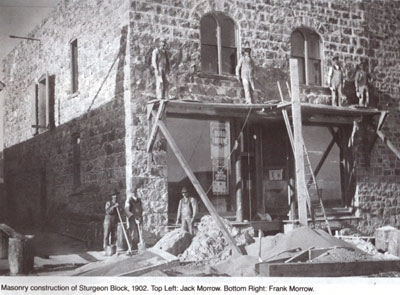|
Frank Morrow was
born in Huron County, near Allenford, Ontario in
1876. He came to Melita the first time in 1906 and joined his brother
J. J. Morrow (John) in the mason trade with plastering and bricklaying.
At this time they assisted in putting the second storey on the stone
block on the comer of Main and Front Street. He returned to Ontario and
came west again in 1908 to marry. He was married at Wilcox,
Saskatchewan on December 16,1908. They came to Melita and the rest of
their lives were spent in Melita.
The Alex A. McRae house and also the Rodney McRae house north of Elva
were built by the Morrow brothers. The Melita sidewalks (one of which
still bears his name stamp) built in 1925, and the archway at
Sourisford Park are examples of their work. Elsewhere, Frank worked on
Banff Springs Hotel.
To supplement his income, Frank was caretaker of the curling and
skating rink for fifteen years or more. He also kept milk cows and we
children delivered milk to many homes in Melita for several years.
Adapted from Our First Century, page 633

The Stonemason
Many of our first settlers brought with them a range of construction
and building skills which served them well and served their new
communities well as they set about creating, in an actual physical
sense, new communities.
The variety of stone buildings; commercial, agricultural and
residential, still standing across the province commemorate the impact
they had. Fine homes still elegant today, sturdy barns and solid
business blocks still fulfilling their functions, exist in many
communities. No other building material makes the same statement: stone
structures reflect an intention of permanence.
Masonry is a very old art form. Early humans started putting stones
together to make homes thousands of years ago, and decorative work with
stone soon followed. Masons pride themselves on creating functional,
beautiful work, which is precisely created for the needs of each
client, whether it be the ornamental foundation stone of a new
building, or a replacement for a worn door mantel. This craft
profession is also unusual in that it cannot be entirely replaced with
mechanization, although modern masons may use advanced tools like water
jets and lasers for cutting.
There are a number of different types of stonemasons. Quarrymen cut raw
stone, sawyers transform the rough blocks of stone cut in quarries into
smaller chunks, while banker masons work in workshops to shape these
pieces of stone as required for a job. In pioneer communities the
mason would be somewhat of a generalist, doing all these tasks.
Some stonemasons talk about being able to read or listen to the rock
that they work with. A good stonemason has learned how different rocks
behave and feel. A fully qualified stonemason is also capable of
working with a wide range of stone, from hard granite to soft
limestone. The pioneer stonemason specialized in working with whatever
stone was at hand.
While commonly used on public buildings and stately homes, the mason’s
skills were also directed towards more modest utilitarian structures:
chicken coops, milk houses, granaries, and yes, even the iconic pioneer
outhouse.
This one remains idle, though fully functional, on an abandoned farm
site near Baldur.
|





